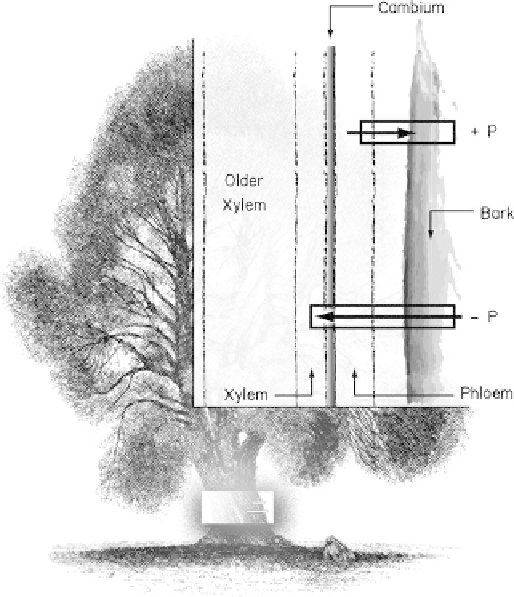Environmental Engineering Reference
In-Depth Information
vials. In order to correlate these samples with tree-core
samples, tree cores were collected at the same time and
placed in 20-mL VOA vials. Prior to analyses of the head-
space for VOCs, the tissue samples were first frozen for 12 h
prior to heating for 4 h. Contaminants were correlated to soil
and groundwater samples collected during this field work.
The relation between the concentration of TCE in core and
branch samples produced a regression coefficient of 0.70.
This approach suggests the applicability of using branch
samples rather than tree cores, at least in areas with little
potential for atmospheric contamination sources for the con-
taminant in question.
TCE also was measured in core, branch, and leaf samples
in areas of the site characterized by high and low levels of
TCE-contamination of soil. The results were unique to each
area. For example, in the area of high TCE-soil contamina-
tion, the concentrations of TCE in the samples increased
from leaf to branch to core sample. The authors stated that
this profile was controlled by TCE mass losses by radial
diffusion (Gopalakrishnan et al. 2007). Such vertical loss
along the transpiration stream also could be explained,
however, by plant detoxification by Phase I and II reactions
with the production of bound residues that were not
analyzed. In the area characterized by low TCE-soil con-
tamination, the exact opposite trend was observed: the TCE
concentrations were higher in the leaves, then core, and then
branch. This may be due to the presence of atmospheric
contamination by TCE and foliar uptake. Moreover, these
TCE profiles were similar to those observed by the authors
for PCE and CCl
4
.
The authors also presented a simple analytical model that
depicted the relations between contaminant and tree pro-
cesses that might control the fate of the contaminant in the
tree tissue (Gopalakrishnan et al. 2007). They added
equations that related the contaminant concentration in the
plant to sorption onto the soil from the soil water; microbial
degradation in the root zone; root uptake by aqueous phase;
and sorption and diffusion from the xylem along the transpi-
ration stream. The authors did not include changes to con-
taminant concentrations that might result from detoxification
reactions or the role that the gaseous uptake of contaminants
might play. The authors also assumed that the transpiration
stream,
Q
, measured in the main trunk before it splits into
two branches is the sum of the
Q
for each branch,
Q
n
.
A topic for further research is the effect of the high
tensions in the xylem on core collection and, therefore, on
the VOC concentrations measured. When a core is collected,
the auger tip breaks through the bark, cortex, and phloem,
which usually is under positive pressures, then the cambium,
and finally the xylem, which usually is under negative
pressures or tensions (Fig.
15.5
). This causes the water
column in the xylem to break, introduce gas, and induce
loss of
Fig. 15.5
The depth of core collection will determine the condition of
pressure (
phloem
) or tension (
xylem
) that can be encountered during
tree-core collection for VOC assessment (P is pressure.).
cavitation on the measured versus
in-situ
concentration of
VOCs is not known.
An additional problem with tree-core tissue collection is
the assumption that the core location is one of growing tissue
and, therefore, metabolically active. Cambial growth to pro-
duce phloem and xylem is not continual, even during the
growing season for the tree being sampled. At certain times
cambial growth will stop, if resources are limiting, for
example. The cambium may be dead on a particular section
and may not produce xylem. These scenarios will affect the
result of cores taken from ring-porous trees and tend to
underestimate the contaminant load (Figs.
15.6
and
15.7
).
The xylem's anatomy also plays an important role in how
contaminants are detected in ring-porous and diffuse-porous
trees. Ring-porous trees have larger diameter xylem vessels
produced in the spring, when moisture is readily available,
and smaller diameter vessels as the season progresses. For
diffuse-porous trees, the xylem vessels are smaller through-
out the season. There is less communication between xylem
vessels, therefore, in diffuse-porous trees.
The key to tree-core utilization is to match the level of
analysis with the needs of the phytoremediation project. For
example, if a rough delineation of groundwater or soil con-
tamination prior to planting is needed, then tree cores can be
used qualitatively to assign plume boundaries. On the other
hand, more rigorous analytical work on the cores would be
tension through cavitation. The effect of
this


Search WWH ::

Custom Search